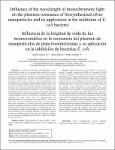ZnO nanoparticles obtained by green synthesis as an alternative to improve the germination characteristics of L. esculentum
| dc.contributor.author | Asmat Campos, David | |
| dc.contributor.author | López Medina, Segundo Eloy | |
| dc.contributor.author | Montes de Oca Vásquez, Gabriela | |
| dc.contributor.author | Gil Rivero, Efrain | |
| dc.contributor.author | Delfín Narciso, Daniel | |
| dc.contributor.author | Juárez-Cortijo, Luis | |
| dc.contributor.author | Villena Zapata, Luigi | |
| dc.contributor.author | Gurreonero Fernández, Julio | |
| dc.contributor.author | Rafael-Amaya, Roly | |
| dc.date.accessioned | 2022-05-07T00:11:33Z | |
| dc.date.available | 2022-05-07T00:11:33Z | |
| dc.date.issued | 2022-04-06 | |
| dc.identifier.citation | Asmat, D., ...[et al.]. (2022). ZnO nanoparticles obtained by green synthesis as an alternative to improve the germination characteristics of L. esculentum. Molecules, 27(7). file:///C:/Users/UPN/Desktop/CI%202022/ARTÍCULOS%20&%20CONFERENCE%20PAPERS/ARTÍCULOS/TRUJILLO%20SAN%20ISIDRO_CIENCIAS/Use%20of%20Onion%20Waste%20as%20Fuel%20for%20the%20Generation%20of%20Bioelectricity.pdf | es_PE |
| dc.identifier.uri | https://hdl.handle.net/11537/30265 | |
| dc.description.abstract | Tomatoisanimportantcropduetoitsnutritionalcontributionsandorganolepticproperties, which make it an appetizing vegetable around the world. In its sowing, the use of seed is the most accessible propagation mechanism for farmers. However, the induction to germination and emergence is often limited in the absence of stimulants that promote the development and growth of the seedling, added to the interference of infectious agents that notoriously reduce the vitality and viability of the seed. Given this, it was proposed as a research objective to determine the effect of zinc oxide nanoparticles (ZnO NPs) mediated by a green route on the germinative characteristics of Lycopersicon esculentum Mill. 1768 “tomato”. The experimental phase consisted of the synthesis of ZnO NPs and its subsequent characterization. After its synthesis, its inoculation was conducted during the germination of seeds of L. esculentum, considering six sample groups for the treatment with zinc nanoparticles (T1: Control; T2: 21.31 ppm; T3: 33.58 ppm; T4: 49.15 ppm; T5: 63.59 and T6: 99.076 ppm). The results indicate that concentrations close to 100 ppm of ZnO NPs are ideal in the treatment of L. esculentum seeds, due to the promotion of enzymatic and metabolic activity to achieve cell elongation; likewise, the biosynthesized nanoparticles showed no phytotoxicity, due to the fact that, in all the treatments, there were processes of germination and emergence. This was linked to the generation of a Zn0-phenolate complex through a chelating effect, which generates compatibilitywiththeseedand,comparedtoclassicinorganicsynthesis,usuallyshowsphytotoxicity. In this sense, green synthesis is presented as a great alternative in this type of application. | es_PE |
| dc.format | application/pdf | es_PE |
| dc.language.iso | eng | es_PE |
| dc.publisher | MDPI | es_PE |
| dc.rights | info:eu-repo/semantics/openAccess | es_PE |
| dc.rights | Atribución-NoComercial-CompartirIgual 3.0 Estados Unidos de América | * |
| dc.rights.uri | https://creativecommons.org/licenses/by-nc-sa/3.0/us/ | * |
| dc.source | Universidad Privada del Norte | es_PE |
| dc.source | Repositorio Institucional - UPN | es_PE |
| dc.subject | Hortalizas | es_PE |
| dc.subject | Cultivos alimenticios | es_PE |
| dc.subject | Zinc | es_PE |
| dc.subject | Fertilizantes | es_PE |
| dc.title | ZnO nanoparticles obtained by green synthesis as an alternative to improve the germination characteristics of L. esculentum | es_PE |
| dc.type | info:eu-repo/semantics/article | es_PE |
| dc.publisher.country | CH | es_PE |
| dc.identifier.journal | Molecules | es_PE |
| dc.description.peer-review | Revisión por pares | es_PE |
| dc.subject.ocde | https://purl.org/pe-repo/ocde/ford#2.11.00 | es_PE |
| dc.description.sede | Trujillo San Isidro | es_PE |







